| ‘ J-PARC News - April 2017 (Issue #144) |
| Commendation for Science and Technology for the FY 2017 announced by the MEXT (Ministry of Education, Culture, Sports, Science and Technology) : prize in Science and Technology - Advanced tire development completed by Sumitomo Rubber Industries, LTD., in liaison with the SPring-8 (Large-Scale Synchrotron Radiation Facility), J-PARC, and K Computer (supercomputer) facilities - |
|---|
| At the Commendation for FY 2017 Science and Technology by the MEXT, a Science and Technology prize in the Development Category was given to the research group led by Dr. Hiroyuki Kishimoto, a manager of the Analysis Center at the Research & Development HQ at Sumitomo Rubber Industries Ltd. This research group is a user of J-PARC's Material and Life Science Experimental Facility (MLF). The prize was given for their development of new fuel-efficient tires with their "ADVANCED 4D NANO DESIGN" new material development technology, which was developed at facilities including the MLF. The group analyzed internal structures of rubber materials accurately and continuously from the nanometer scale to the micron scale and simulated their behaviors. As a result, abrasion resistance increased by 51% over the existing products while maintaining a high level of fuel efficiency and grip performance. These newly developed fuel-efficient tires are already commercialized. |
| |
| £to Page Top |
| |
|
| The 49th Atomic Energy Society of Japan Award winner was announced (March 28th, Tokai University Shonan campus). - Paper on the development of a bubble generator for the reduction of pressure waves at the mercury target - |
|---|
| On March 28th, Dr. Hiroyuki Kogawa and Dr. Takashi Naoe from the Neutron Source Section of J-PARC Center, along with a professor of the University of Tsukuba, Harumichi Kyotoh, won the 49th AESJ (Atomic Energy Society of Japan) Best Paper Award. In order to generate neutron beams, high-intensity proton beams are injected into a liquid mercury target. However, rapidly increasing pressure waves damage the target mercury vessel. Dr. Kogawa and others from the research group, developed the technology to inject micro-bubbles into the flowing mercury. The bubbles act as a cushion to reduce the rapid pressure rise. This development was achieved by utilizing the micro-bubble generator developed by Prof. Harumichi Kyotoh of University of Tsukuba. He developed the device to purify water in lakes and ponds, like Kasumigaura. The specifications of this device were studied in detail and optimized for use in flowing mercury in place of water. |
| |
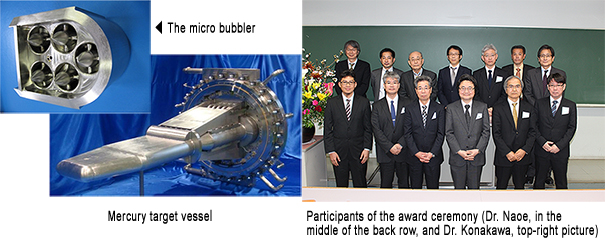
 * Click here to enlarge. * Click here to enlarge. |
| |
| £to Page Top |
| |
|
| Hiraishi and Okabe awarded the Encouragement Prizes of FY 2017 by the Society of Muon and Meson Science of Japan (March 19, Japanese Society for Neutron Science). |
|---|
| Dr. Masatoshi Hiraishi (KEK research fellow) won the "Young Researcher Encouragement Prize", and Dr. Hirotaka Okabe (KEK research associate) won the "Encouragement Prize". Both are from J-PARC Center Muon Section. On March 19th, the prizes were awarded during a plenary meeting of the organization at Osaka University Toyonaka campus. The organization has established the prizes to honor members for excellent papers, which can contribute to muon science development, thus invigorating the organization. Dr. Hiraishi was awarded for his accomplishments in "The Study of Iron-based Superconductors Using Muon Spin Rotation/Relaxation Method". Dr. Okabe was awarded for his accomplishments in "The Study of Superconductivity of Spin-Orbit Coupling Induced Mott Insulator byμSR". The expectations are high for their future works in the field of magnetism and superconductivity research, the development of the muon science community, and more. |
| |
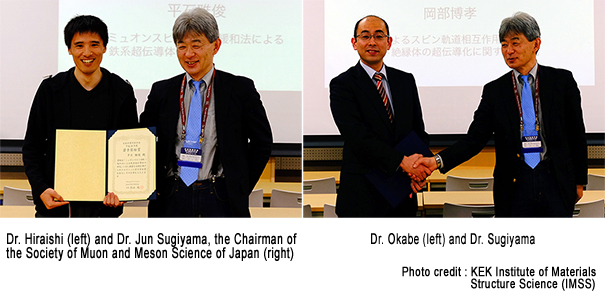
 * Click here to enlarge. * Click here to enlarge. |
| |
| £to Page Top |
| |
|
| Development of an analysis method for crystal structures of new materials, using mathematical graph analysis (April 20th, press conference) |
|---|
| Ryoko Tomiyasu, an associate professor of Yamagata University, and Takashi Kamiyama of the J-PARC Center Neutron Section, a professor of High Energy Accelerator Research Organization (KEK), developed new software which showed a great improvement over the existing method on the success rate and calculation efficiency of the determination of crystal lattices. It applies a mathematical theory in graph analysis for analyzing data obtained from experiments using powder X ray/neutron diffractometer. A powder diffractometer is used on a daily basis in manufacturing companies and research institutes, thus this achievement will be an important key to speed up new material development. Prof. Kamiyama is also a supervisor for the Super High Resolution Powder Diffractometer (SuperHRPD) at J-PARC Material Life Science Facility (MLF). The results of this research will be published in the 2017 April issue of the Journal of Applied Crystallography, an academic journal published by the International Union of Crystallography. |
| |
| £to Page Top |
| |
|
| T2K to finish experiment Run8, achieving a total proton irradiation of 2.25 ~ 1021. |
|---|
| The T2K experiment group, which started obtaining their data in 2010, ended its 8th term, "Run8", on April 12th, 2017. During Run8 at MR (Main Ring), steady-30GeV-operation generated beams reaching an intensity of 470 kW. The group also tried for the first time to produce a high power beam of up to 511 kW at the Neutrino Beam Line. As a result of a higher-power beam produced by the accelerator, the experiment successfully recorded the highest number of irradiated protons (7.26x1020) that hit the graphite target during the Run8 period. The total since the experiment began in January 2010 reached 2.25x1021. This POT (protons on target) was a 50% increase from the numbers obtained through Run7, and the data from the experiments using neutrinos almost doubled. Data from Run8 will be analyzed and discussed by an international joint study group, and the results will be presented at international conferences and seminars this summer. |
| |
| £to Page Top |
| |
|
| The 22nd International Collaboration on Advanced Neutron Sources "ICANS XXII" (March 27-31, Oxford, United Kingdom) |
|---|
| From March 27th to March 31st, the international conference "ICANS" was held in Oxford, United Kingdom to discuss international cooperation on the latest neutron sources and neutron experiment devices. About 280 participants gathered from 20 countries around the world. From the J-PARC Center, Dr. Kenji Nakajima, the leader of Neutron Science Section, and others gave reports on J-PARC's neutron sources and instruments, and their experience since 2015 on a series of problems and the recovery of a radiation source. Also, they presented the MLF's new device, RADEN (energy-resolved neutron imaging system), and their achievements with the system. They had a great discussion with the participants. |
| |
| £to Page Top |
| |
|
| J-PARC Workshop : "Neutron Biology for Next Generation" (March 22, IQBRC) |
|---|
| On March 22nd, J-PARC Center held a workshop, "Neutron Biology for the Next Generation" at Ibaraki Quantum Beam Research Center (IQBRC) with Professor Masaaki Sugiyama from Kyoto University Research Reactor Institute, as committee chair. Up-and-coming European neutron biology researchers, Dr. Ralf Biehl (JCNS* 1) and Dr. Frank Gabel (IBS*2) were joined by 40 researchers in Japan including neutron biology researchers and researchers in related fields to exchange reports and have casual discussions on devices and research. From the J-PARC Center, Dr. Shinichi Takata of the Neutron Science Section and others reported on the MLF beamlines and their usage in experiments. |
| * 1: Jülich Centre for Neutron Science (Germany) |
| * 2: Institut de Biologie Structurale (France) |
| |
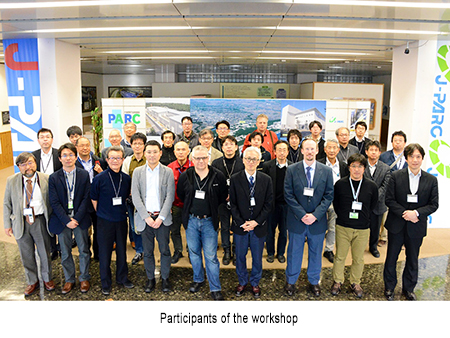
 * Click here to enlarge. * Click here to enlarge. |
| |
| £to Page Top |
| |
|
| The 58th Science and Technology Week with "Beauty" of science and technology panel exhibition (April 17-28, Tokyo) |
|---|
| On the last day of the 58th Science and Technology Week (April 17th ? 23rd), Science Cafe was held at the Science Museum, where Dr. Shinichi Sakamoto and Dr. Tatsuya Uzumaki from the Public Relations Section of J-PARC Center gave a lecture and scientific experiments to the public. It was entitled, "Naminaminaranu wave power (extraordinary power of waves) -from water waves to subatomic particles and to space". The participants were quite interested to see the experiments on waves created by sounds, which explained the Neutrino oscillations in the T2K experiments conducted by J-PARC and other groups. In addition, Dr. Uzumaki's photograph, "The Detection Instruments for Capturing Positrons from Worldfs-Highest-Intensity-Muon Decay", was selected for the panel exhibition "Beauty" of science and technology. It was one of 25 works exhibited at the "Joho Hiroba" (the Museum of MEXT) from 17th to 28th. |
| |
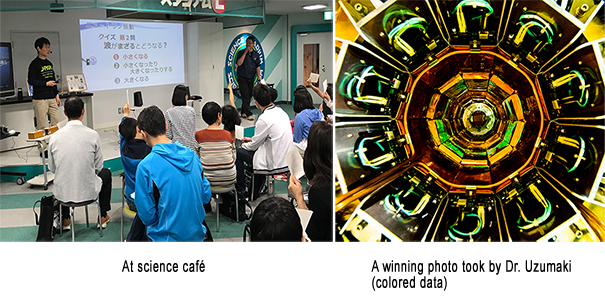
 * Click here to enlarge. * Click here to enlarge. |
| |
| £to Page Top |
| |
|
| J-PARC "Hello Science" in Nishitokyo City (March 29, Nishitokyo City) |
|---|
| On March 29, "Hello Science" with a theme "Naminaminaranu wave power (extraordinary power of waves)" was held in Nishitokyo city. Joining the event were 40 participants, consisting of elementary student members from the Children's Studio for Creative Thinking (Chibikko Atelier) and their mothers, and alumni members who were middle to high school students. They created a wave-machine by patiently connecting a number of straws with scotch-tape, and then observed the wave motion it generated. The participants also made a kaleidoscope of light with a spectral sheet. By pointing the kaleidoscopes at a fluorescent light and the blue sky, they discovered differences in the rainbows created by different light sources. |
| |
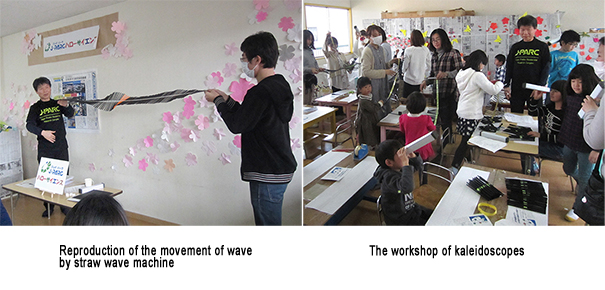 |
| |
| £to Page Top |
| |
|
©2017 J-PARC Center. All rights reserved.
|
|